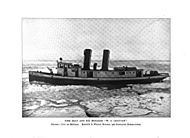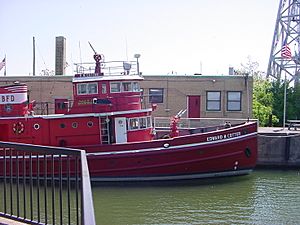Edward M. Cotter (fireboat) facts for kids

Edward M. Cotter escorting USS Little Rock (LCS-9).
|
|
| History | |
|---|---|
| Name | William S. Grattan (Engine 20) |
| Operator | Buffalo Fire Department |
| Builder | Crescent Shipbuilding of Elizabeth City, New Jersey |
| Cost | $91,000 |
| Laid down | March 24, 1900 |
| Sponsored by | Virginia Pearson |
| Christened | September 5, 1900 by Virginia Pearson |
| Renamed |
|
| Refit |
|
| General characteristics | |
| Type | Fireboat |
| Tonnage |
|
| Length | 118 ft (36 m) |
| Beam | 24 ft (7.3 m) |
| Draft | 10 ft 10 in (3.30 m) |
| Ice class | 1.5 in (38.1 mm) thick belt line of Swedish steel around the icebreaking part of the hull |
| Installed power |
|
| Propulsion |
|
| Speed |
|
| Capacity | |
| Notes |
|
|
Edward M. Cotter
|
|
 |
|
| Lua error in Module:Location_map at line 420: attempt to index field 'wikibase' (a nil value). | |
| Location | Buffalo, New York |
| Built | 1900 |
| Architect | Crescent Shipbuilding Co. |
| NRHP reference No. | 96000968 |
| Significant dates | |
| Added to NRHP | June 28, 1996 |
| Designated NHL | June 28, 1996 |
The Edward M. Cotter is a special fireboat that works for the Buffalo Fire Department in Buffalo, New York. It was built way back in 1900 and was first named William S. Grattan. This amazing boat is thought to be the oldest active fireboat in the whole world!
Because it's so old and important, the Edward M. Cotter was named a National Historic Landmark in 1996. Besides fighting fires, it also helps break ice on Buffalo's rivers during winter. The boat has five powerful water cannons, called fire monitors, that can pump a huge amount of water – about 15,000 gallons every minute! You can often see it sailing on Lake Erie, showing off its water cannons.
Contents
Building the Edward M. Cotter
The ship we know as the Edward M. Cotter was built in 1900. It was made by the Crescent Shipyard in Elizabeth Port, New Jersey. Its first name was William S. Grattan, honoring Buffalo's first paid fire commissioner.
Work on the ship started on March 24, 1900. It was officially named on September 5, 1900, by Virginia Pearson. She was the young daughter of one of the city's fire commissioners. The ship cost $91,000 to build, which was a lot of money back then!
When finished, the ship was about 118 feet (36 meters) long. It was 24 feet (7.3 meters) wide and sat 10 feet 10 inches (3.3 meters) deep in the water. It had a special 1.5-inch-thick (38 mm) steel belt around its hull. This strong steel helped it break through ice.
The William S. Grattan was powered by two large coal-fired boilers. These boilers ran steam engines that made 900 horsepower. A single propeller pushed the ship through the water. It could travel at a speed of 13 knots (about 15 miles per hour).
For firefighting, the ship had three steam pumps. These pumps could deliver 9,000 gallons of water per minute. This water went to three fire monitors. Two monitors were at the front of the ship, and one was at the back.
A Look Back: The Ship's History
In the early 1900s, Buffalo's waterfront was a very busy place. There were many grain elevators, warehouses, and ships. The city's two existing fireboats couldn't handle all the fire protection needed. Also, fireboats could connect to special pipes on the shore. This allowed them to send high-pressure water to fire hydrants downtown. So, the city decided to get a third fireboat. This new boat would also be able to break ice.
After it was built, the ship sailed a long way to Buffalo. It traveled up the Atlantic coast, down the Saint Lawrence River, across Lake Ontario, through the Welland Canal, and finally across Lake Erie. The trip took 14 days and went smoothly. As it neared Buffalo, its sister fireboats met it. They escorted the new ship into the harbor.
The 1928 Fire Incident
On July 28, 1928, the William S. Grattan responded to a big fire. An oil barge named James F. Cahill was burning with 5,000 barrels of crude oil. After burning for 17 hours, the barge broke free and started to drift. The crew of the William S. Grattan tried to attach tow lines. But the barge hit a dock where an empty oil tanker was parked.
Fumes on the tanker exploded, causing a huge fire that surrounded the William S. Grattan. The captain and crew had to jump into the flames to swim to safety. Sadly, the Chief Engineer of the William S. Grattan lost his life. Seven other crew members were hurt. The ship's boilers, left unattended, soon ran dry and exploded. This left the William S. Grattan badly damaged and burned out.
The ship sat unused for 18 months. City officials had to decide whether to buy a new boat for $225,000 or rebuild the old one for $99,000. They chose to rebuild it. In 1930, the ship was rebuilt at the Buffalo Dry Dock Company. During this repair, some great improvements were made. The boilers were changed from burning coal to burning oil. The engines were fixed, and the firefighting system was updated. It could now even spray foam to fight fires.
The ship's pilot house (where the captain steers) was moved higher up. A fixed water cannon tower was added to the back of the ship. A fourth fire monitor was also added to the top of the pilot house. To celebrate its return, the ship even raced against a fast tugboat called Kentucky.
Major Upgrades in 1953
By the early 1950s, the William S. Grattan was showing its age. Its boilers could only work at 40 percent power. In 1951, a steam leak in the engine room injured some crew members. So, in November 1952, the ship was sent for a big upgrade. It went to the Sturgeon Bay Shipbuilding & Dry Dock Company in Wisconsin.
During this major refit, its old boilers and steam engines were replaced with powerful diesel engines. The pumps for firefighting were also replaced with stronger ones. The ship's single propeller was changed to twin propellers, making it more maneuverable. A new, hydraulically operated platform was added for firefighting. The two tall smokestacks were replaced with shorter, dummy ones.
When the ship returned in 1954, it was renamed Firefighter. A year later, in 1955, it was renamed again. This time, it was named Edward M. Cotter, after a respected Buffalo firefighter who had recently passed away. After these upgrades, the Edward M. Cotter had five fire monitors. These could pump an amazing 15,000 gallons of water per minute!
Helping Other Countries: International Firefighting
On October 7, 1960, the Edward M. Cotter made history. It went to help firefighters in Port Colborne, Ontario, Canada. Two days earlier, a huge fire had broken out at an eight-story grain elevator. The Port Colborne Fire Department didn't have its own fireboat and couldn't control the blaze.
So, they asked the Buffalo Fire Department for help. The Edward M. Cotter was sent, escorted by a United States Coast Guard cutter. The fireboat didn't have its own navigation equipment, as it usually stayed close to home. The trip to Port Colborne took two hours. It then took four more hours to get the fire under control. This mission was the first time a United States fireboat had crossed an international border to help another country!
Amazing Rescues by the Cotter
The Edward M. Cotter has been involved in many important rescues.
- In 1978, the USS Little Rock (CL-92), a retired Navy ship on display, started taking on water. The Edward M. Cotter and other Buffalo fire engines pumped water out of the Little Rock for five days. This kept the ship afloat and level until repairs could be made.
- In the winter of 1983, the Edward M. Cotter helped the Coast Guard cutter Ojibwa. The Ojibwa had lost its steering on Lake Erie and was taking on water. The Edward M. Cotter towed the Ojibwa back to its base in Buffalo. It also helped keep it afloat while repairs were done.
- On July 31, 1984, the Edward M. Cotter rescued the Polish tall ship Zawisza Czarny. The tall ship had gotten stuck on a sandbar during its visit to Buffalo. The Cotter successfully towed it free.
A Historic Ship: The Cotter's Legacy
As shipping on Buffalo's waterfront became less busy, the Edward M. Cotter was moved. In 1992, it went from the Fire Department to the Public Works Department. Its main job then was icebreaking. In 1996, the Edward M. Cotter was named a National Historic Landmark. This means it's a very important part of American history. In 1997, it was transferred back to the Buffalo Fire Department.
A group called "Friends of the Cotter" was started in 2005. This non-profit group works to raise money to keep the Edward M. Cotter in great shape. Besides its daily duties, the Edward M. Cotter also travels to different festivals and boat shows around the Great Lakes.
Other Fireboats on the Great Lakes
The Edward M. Cotter is one of a few special fireboats that work on the Great Lakes:
- The William Lyon Mackenzie is used by the Toronto Fire Service. It works in Lake Ontario.
- The Curtis Randolph is operated by the Detroit Fire Department. It works in the Detroit River.
Images for kids




